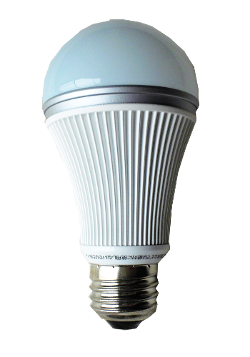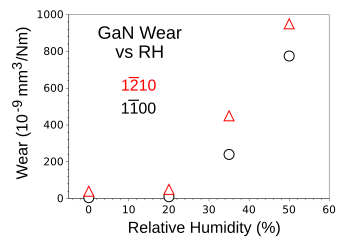Gallium Nitride Tribology
December 1, 2016
The first
light-emitting diodes (LEDs) produced light in the
infrared. While they were not useful for
display applications, they enabled
optical free-space communication devices, such as
television remote controls, and
fiberoptic communication over short links. The first
visible light LED, a red light emitter, was invented by
Nick Holonyak, Jr., in 1962. This led to a
plethora of LED
numerical displays and indicator lamps on
electronic equipment.
In just a few years thereafter, new
materials enabled fabrication of LEDs in colors from green through red, with yellow and orange in between. However, blue light LED emission was elusive for the principal reason that blue light is
energetic, so a high
energy electron transition is required for its emission as well as a material that can host such a transition.

For many decades, these were the only LED colors present in my component drawers.
(Wikimedia Commons image by Afrank99.)
A
decade after the invention of the red LED,
researchers at
Stanford University made a blue LED from
magnesium-
doped gallium nitride (GaN) combined with an
n-doped layer of gallium nitride, prepared on a
sapphire substrate. Undoped gallium nitride is
n-type, as
grown, with a
carrier concentration greater than 10
18 cm-3. The addition of magnesium produces
deep acceptors that compensates the native donors in GaN to make it
intrinsic. This allowed the formation of an intrinsic-n
junction diode.[1]
Blue LEDs finally arrived when
Shuji Nakamura discovered an inexpensive
thermal annealing technique to fabricate
p-type GaN. Nakamura shared the 2014
Nobel Prize in Physics with two other
Japanese scientists for their work on blue LEDs.
The award of this
Nobel Prize was not without controversy, since no Nobel Prize was awarded to anyone involved with the initial discovery of LEDs. My
analysis of the matter is that there were so many of these early LED researchers that it's hard to select certain prominent individuals from that group. Interestingly, the LED award follows also in the "
tradition" of the Nobel Prize for the
laser, in which
Theodore Maiman, who made the first working laser, was excluded.
The Nobel Prizes are awarded "to those who, during the preceding year, shall have conferred the greatest benefit on mankind."[2] While it's nice to have an LED
alarm clock, blue LEDs have enabled replacement of less
efficient lighting technologies, and such an energy savings has a definite benefit to mankind.

Wonderful - When they work.
When incandescent bulbs were effectively outlawed in the US, I started buying LED bulbs. My earliest purchases had nearly a 50% failure rate in their first year, likely the power conversion electronics, and not the LEDS themselves.
(Via Wikimedia Commons.)
While the
electronic and
optical properties of gallium nitride have been thoroughly investigated, there's still much to learn about its
mechanical properties.
Nitrides are diverse materials, with
boron nitride (BN) having
graphite-like properties, and
titanium nitride (TiN) being an extremely
hard ceramic. Titanium nitride is the
golden coating seen on
drill bits that increases their
useful life.

"Tool's gold." The gold on tools such as drill bits is titanium nitride. (Wikimedia Commons image by Peter Binter.)
Mechanical engineers and
electrical engineers at
Lehigh University (Bethlehem, Pennsylvania) have looked at the
tribological (friction/wear) properties of GaN, and they found that it is extremely
wear resistant, approaching the wear rates reported for
diamond.[3-4] The research was conducted by
Guosong Zeng, a
graduate student in
mechanical engineering,
Nelson Tansu, a
professor of
Electrical and Computer Engineering at Lehigh and
director of the Lehigh
Center for Photonics and Nanoelectronics,
Brandon A. Krick, an
assistant professors of
Mechanical Engineering and Mechanics, and
Chee-Keong Tan, a recent Lehigh
Ph.D. who is now an assistant professor of
Electrical and Computer Engineering at Clarkson University.[4]
This research group was the first to examine the wear performance of gallium nitride. Says paper
co-author, Brandon Krick,
"Nelson [Tansu] asked me if anyone had ever investigated the friction and wear properties of gallium nitride... and I said I didn't know. We checked later and found a wide-open field."[4]
The research team used a custom
microtribometer to measure the wear rate and
friction coefficients of GaN by dry sliding wear
experiments. Wear is typically seen for most materials after just a thousand sliding cycles, but the GaN wear wasn't evident for 30,000 cycles.[4] They found that the wear rate ranged from 10
-7 to 10
-9 mm3/
Nm. For comparison, the wear rate for
chalk is the high value of 10
2,
silicon is 10
-4, and diamond ranges from 10
-9 to 10
-10.[4]
The wear resistance depended on the
crystallographic direction, with sliding in the <⟨1
210⟩> direction having significantly lower wear than for <⟨1
100⟩>.[3] One surprise was the affect of
humidity. Wear increases by two
orders of magnitude with a
relative humidity change from 0% to 50%.[3] Says Zeng,
"The first time we observed the ultralow wear rate of GaN was in winter... These results could not be replicated in summer, when the material's wear rate increased by two orders of magnitude."[4]

Gallium nitride wear vs relative humidity.
(Graphed using Gnumeric from data in ref. 3.[3]
Subsequent experiments were undertaken under controlled humidity.[4] It's suspected that humidity
strains the surface
lattice, leading to the enhanced wear.[4]
Since GaN has excellent
radiation resistance, it's a candidate material for
solar cells on
spacecraft. The wear resistance will inhibit
erosion by
cosmic dust.[4] Tansu points out that the wear properties of GaN, combined with its high strength, would allow thin layers to be used in
flexible electronics.[4]
References:
- D. Stevenson, W. Rhines, and H. Maruska, "Gallium nitride metal-semiconductor junction light emitting diode, US Patent No. 3,819,974, June 25, 1974.
- Full Text of Alfred Nobel's Will, Nobelprize.org
- Guosong Zeng, Chee-Keong Tan, Nelson Tansu, and Brandon A. Krick, "Ultralow wear of gallium nitride," Appl. Phys. Lett., vol. 109, no. 5 (August 3, 2016), Article No. 051602, http://dx.doi.org/10.1063/1.4960375.
- Researchers surprised at the unexpected hardness of gallium nitride, Lehigh University Press Release, October 28, 2016.
Permanent Link to this article
Linked Keywords: Light-emitting diode; infrared; display device; optical free-space communication; television remote control; fiberoptic communication; visible light; Nick Holonyak, Jr.; plethora; seven-segment display; numerical display; electronic equipment; material; energetic; energy; atomic electron transition; decade; component; Wikimedia Commons; Afrank99; researcher; Stanford University; magnesium; doping; dope; gallium nitride; n-type semiconductor; n-doped; sapphire; wafer; substrate; crystal growth; grow; charge carrier; concentration; centimeter; cm; deep acceptor; intrinsic semiconductor; junction diode; Shuji Nakamura; thermal annealing; p-type semiconductor; Nobel Prize in Physics; Japan; Japanese; scientist; Nobel Prize; analysis; tradition; laser; Theodore Maiman; alarm clock; energy conversion efficiency; efficient; lighting; technology; technologies; incandescent light bulb; phase-out of incandescent light bulbs; LED bulb; failure rate; power conversion electronics; optics; optical; mechanical properties; nitride; boron nitride (BN); graphite; titanium nitride (TiN); hardness; hard; ceramic; gold; golden; coating; drill bit; service life; useful life; tool; mechanical engineer; electrical engineer; Lehigh University (Bethlehem, Pennsylvania); tribology; tribological; wear; diamond; Guosong Zeng; postgraduate education; graduate student; Nelson Tansu; professor; Electrical and Computer Engineering at Lehigh; director; Center for Photonics and Nanoelectronics; Brandon A. Krick; assistant professor; Mechanical Engineering and Mechanics at Lehigh; Chee-Keong Tan; Doctor of Philosophy; Ph.D.; Electrical and Computer Engineering at Clarkson University; co-author; microtribometer; coefficient of friction; friction coefficient; experiments; millimeter; mm; newton; N; meter; m; chalk; silicon; Miller index; crystallographic direction; humidity; orders of magnitude; relative humidity; winter; summer; Gnumeric; deformation; strain; crystal structure; lattice; radioactive decay; radiation; solar cell; spacecraft; erosion; cosmic dust; flexible electronics; D. Stevenson, W. Rhines, and H. Maruska, "Gallium nitride metal-semiconductor junction light emitting diode, US Patent No. 3,819,974, June 25, 1974.